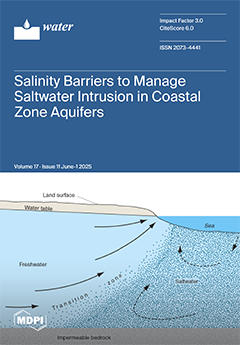This study investigates the effectiveness of electrocoagulation (EC) with locally sourced iron electrodes for treating olive mill wastewater (OMW) prior to adsorption with olive stone (OS). Using Response Surface Methodology (RSM), 60 experiments were conducted to evaluate various operational parameters, including current density
[...] Read more.
This study investigates the effectiveness of electrocoagulation (EC) with locally sourced iron electrodes for treating olive mill wastewater (OMW) prior to adsorption with olive stone (OS). Using Response Surface Methodology (RSM), 60 experiments were conducted to evaluate various operational parameters, including current density (CD), reaction time (T), distance between electrodes (D), and the number of electrodes (N). The optimal conditions identified were a reaction time of 53.49 min, a current density of 15.1104 mA/cm
2, 1 cm electrode spacing, and six electrodes. Under these conditions, the removal efficiencies achieved were 54.46% for total phenols (TPh), 73.25% for total Kjeldahl nitrogen (TKN), 92% for turbidity, 58.91% for soluble chemical oxygen demand (COD
soluble), and 58.55% for total COD (COD
total), with an energy consumption of 14.3146 kWh/m
3 and a projected cost of USD 3.92/m
3. Following the EC process, the treated OMW underwent further adsorption using OS, enhancing pollutant removal. The combined EC and adsorption (ECA) method demonstrated superior performance, achieving TPh removal at 62.63%, TKN removal at 77.52%, and turbidity reduction at 83.73%. Additionally, COD
total removal increased to 72.88% with COD
soluble removal at 70.04%. This integrated approach significantly improves pollutant removal, presenting a promising solution for effective OMW treatment.
Full article





